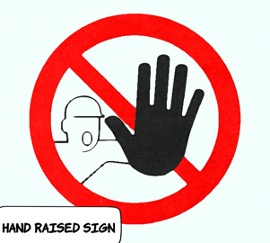Gaining access to restricted places is something we’ve all faced in some way or another.
Whether it’s a friend’s house, a building you don’t have permission to enter, or out-of-bounds areas, there are times when you need to find the words that politely inform someone they’re not allowed inside.
This post will provide ten polite phrases and lines that can be used to tell somebody not to enter. Read on for useful tips on how to say “Do Not Enter” without offending anyone.
10 Polite ‘Do Not Enter’ Phrases or Lines
Having the right phrases can help you express yourself in a respectful and calming manner. Here are 10 polite “Do Not Enter” phrases or lines that can be used in various situations.
- Thank You for Understanding That This Space Is Private
- I’m Afraid I’m Not at Liberty to Let You In.
- This Is a Restricted Area, Unfortunately
- I’m sorry, but Entry Beyond This Point Is Not Allowed.
- I’m Afraid I Must Ask You to Not Go Any Further.
- I Hope You Understand This Is a Secure Area.
- This Area is Currently Off-Limits.
- I’m Sorry, I Can’t Let You in Here Just Yet
- Do You Mind if I Ask You to Not Come In?
- Regrettably, This Section Is Closed Right Now
Thank You for Understanding That This Space Is Private

I am sure you have come across the phrase ‘Thank You for Understanding That This Space Is Private’ in your life.
This phrase is often used as a polite reminder to others that a specific area is off-limits and should not be entered. It also conveys a sense of appreciation for the other person being conscious of the privacy that you are seeking.
It can be used in a variety of contexts, such as in a business, at home, or even at an event.
I’m Afraid I’m Not at Liberty to Let You In
As someone who works in a facility with restricted access, one of my common phrases to tell people they cannot enter is: ‘I’m afraid I’m not at liberty to let you in.’ using this phrase allows me to politely deny entry without causing offense
People often understand that I’m simply following the rules to keep the building safe.
This Is a Restricted Area, Unfortunately
In many organizations, such as military bases, government organizations, and other places with security risks, this line is used on signs and spoken to those without the necessary clearance.
For example, if someone without proper clearance approaches the front gate of a military base, the guard will explain that only those with proper authorization may enter and respond with ‘This is a restricted area, unfortunately.’
The same statement can be used in many different organizations, such as office buildings or schools.
The added ‘unfortunately’ softens the phrase a bit and allows the speaker to appear more polite than if they were to just say This is restricted.’
I’m Sorry, but Entry Beyond This Point Is Not Allowed
My fourth phrase conveys a politeness that we can all try to show when we are the ones notifying someone of a ‘Do Not Enter’ situation.
Saying ‘I’m sorry, but entry beyond this point is not allowed’ is a polite and apologetic way to tell someone that they cannot go beyond a certain point.
I’m Afraid I Must Ask You to Not Go Any Further

I’m afraid I must ask you to not go any further is a polite and firm way to inform an individual that they can no longer proceed.
It conveys to the person that their presence is no longer desired and that it is time for them to turn back.
Like when an employee or individual tries to enter a meeting without an invitation, they may be asked to not go any further in order to respect those who are attending.
I Hope You Understand This Is a Secure Area.
When I say, ‘I hope you understand this is a secure area,’ I’m communicating that the space in question should not be entered and is safe from intruders.
This phrase is polite but firm, making it an appropriate way to remind people that an area is off-limits.
This polite line/phrase can be used to ensure privacy and security in homes, workplaces, and public places.
This Area is Currently Off-limits
‘This area is currently off-limits’ is a polite but strong request for someone to stay put.
This phrase is commonly used in a few real-life scenarios, ranging from protecting the property of an individual to preventing people from entering a restricted area.
I’m Sorry, I Can’t Let You in Here Just Yet

‘I’m Sorry, I Can’t Let You in Here Just Yet’ is a gentler and more apologetic way to ask someone not to enter a space.
It can be used in many situations where you may be afraid of hurting someone’s feelings.
Like, if you have a roommate who is generally messy and uses up all the space in the room, you may use this phrase to kindly ask them not to enter the shared space when it’s just been tidied up.
It conveys an understanding of the situation and an apology for not being able to let them in.
Do You Mind if I Ask You to Not Come In?
I’m sure all of us have been in a situation where someone we don’t want to interact with enters an area that is ‘off-limits’, such as our home, workplace, or other private areas.
In such cases, it is important to let the person know that they are not welcome in an appropriate way, without getting too confrontational.
One phrase that can be used to politely let someone know not to enter is ‘Do you mind if I ask you to not come in?’
This phrase is a good way to be polite and respect the person’s feelings while also maintaining the boundary.
Regrettably, This Section Is Closed Right Now.
As a manager of a retail store, I have been forced to close certain sections due to stock shortages or due to pandemic-related events like limited storage capacity.
Our employees were tasked with informing customers of the closure and politely telling them to not enter a certain section.
We decided that saying ‘Regrettably, This Section Is Closed Right Now’ was the most polite and straightforward way of saying this.
10 Polite ‘Do Not Enter’ Signs/Gestures
Let’s dive into the 10 polite ways to communicate ‘do not enter’ while still maintaining respect and good manners.
- Hand Raised
- Palm Facing Outward
- Crossed Arms
- Step Back Gesture
- Folding Your Arms While Indicating ‘No’ With Head Shake
- Blank Stare or Disinterested Glance
- Waving Your Hand in a Stop Motion
- Holding the Door Closed
- The Eye-Roll Signal
- Blocking Pathways With Objects
Hand Raised

When I want to politely indicate ‘Do Not Enter’, one gesture I use is the ‘Hand Raised’. It’s a natural, nonverbal way to politely make a clear boundary that visitors should not cross.
To do the Hand Raised gesture, all you need to do is raise your left or right arm and gently wave it from side to side with your palm out.
It’s a universal gesture understood by almost everyone, and in many cases, it is more effective than a sign.
Palm Facing Outward
When a person needs to signal someone not to enter a certain area, ‘Palm Facing Outward’ is one of the most polite and straightforward ways to do so.
To demonstrate this gesture most effectively, the person’s arm should be extended at chest height, and the palm is kept forward-facing in an open position.
While this is an inherently non-aggressive action, the relative firmness and confidence of the gesture are essential to conveying its true intent: Do Not ENTER!
Crossed Arms

Crossed arms are one of the most common ‘do not enter’ signs or gestures. It is a powerful body language sign that is used to express disapproval.
When I cross my arms, it is a sign that I am feeling defensive, uncomfortable, or perhaps even hostile. It is a sign that I don’t want anyone to come too close to me or enter my physical space.
This sign is used in various ways to communicate disapproval or emotions such as discomfort, defense, power dynamics, and shame.
Step Back Gesture
When it comes to the ‘Step Back Gesture’, it is best used when politely asking someone to not enter a certain area without being overly intrusive.
In a subtle, gentle manner, this gesture can be used to inform someone of your boundaries and to politely communicate that an entry is undesirable.
To begin, the person executing the gesture should slowly and calmly step backward with the arms outstretched. This should serve as a visual indication that entry is not desirable.
The Step Back Gesture can be an effective and respectful tool, when used correctly, it can create a pleasant and respectful atmosphere for both parties.
Folding Your Arms While Indicating ‘No’ With Head Shake
Folding Your arms while indicating ‘no’ with a head shake is a polite gesture to make when someone tries to enter a place that they shouldn’t.
I recently had a neighbor come over to my house when I wasn’t expecting any visitors. I could tell that he was hoping to come inside, so when he asked if he could come in, I simply folded my arms, shook my head, and said no. He accepted my answer, acted respectfully, and left.
Blank Stare or Disinterested Glance

Blank Stare or disinterested glance is a great way to let someone know to keep their distance. The primary goal is to avoid stoking an altercation if the person disregards a verbal or written plea.
When someone I don’t want to deal with intrudes onto my personal space, I crack my gaze and aim it vaguely at the person.
I make sure not to make it too strong, lest I be interpreted as aggressive. This usually gives the person the hint that I don’t want to engage in a conversation.
In short, the nonverbal way to convey a “do not enter” sign is a more powerful and subtle tool as opposed to a vocal or physical technique. It is effective if done right and would halt most unwanted intruders.
Waving Your Hand in a Stop Motion
waving your hand in a stop motion. This is a typical gesture that can be seen in many everyday situations, yet it still packs the same heavyweight as a ‘do not enter’ sign.
The idea behind the gesture is that the person in front of you – be they a friend, colleague, family member, or stranger – will understand what you are trying to say.
Holding the Door Closed
It involves holding a door closed from the inside to prevent access from the outside. To do this, someone standing inside the space holds the door’s handle, latch, or lock to physically block any kind of entry.
Also, there are times when holding the door closed is mandatory, such as when there is a fire or other emergency.
During such times, the doors must be closed to contain the danger and restrict any extra radiation from outside sources.
The Eye-Roll Signal

The eye-roll signal is a subtle way of saying ‘no’ without actually having to say it. It involves rolling one’s eyes up toward the ceiling in exasperation. It’s a very easy gesture to recognize and understand, even without a word being said.
It’s also a great way to communicate your desire to politely end a conversation or show your dissatisfaction with a situation without having to speak too harshly or explicitly.
Blocking Pathways With Objects
Blocking pathways with objects is a great way to get your message across without having to say a word. In my daily life, I find myself employing this technique often.
In my home, I keep the door to the attic propped open with two large boxes to avert anyone from entering the room.
Using physical objects to block a pathway is an effective way to let people know to keep out without needing to verbally communicate.
It also acts as a deterrent by showing that you mean business and are serious about not allowing people to enter the space.
Wrapping Up
Learning polite ways to say “Do Not Enter” is a valuable tool for both businesses and individuals.
It can be used in various scenarios not only as a physical barrier but also as a way of encouraging customers or visitors to follow rules and regulations.
By being considerate of everyone’s needs, we can create an environment where everyone feels respected and safe, no matter the situation.